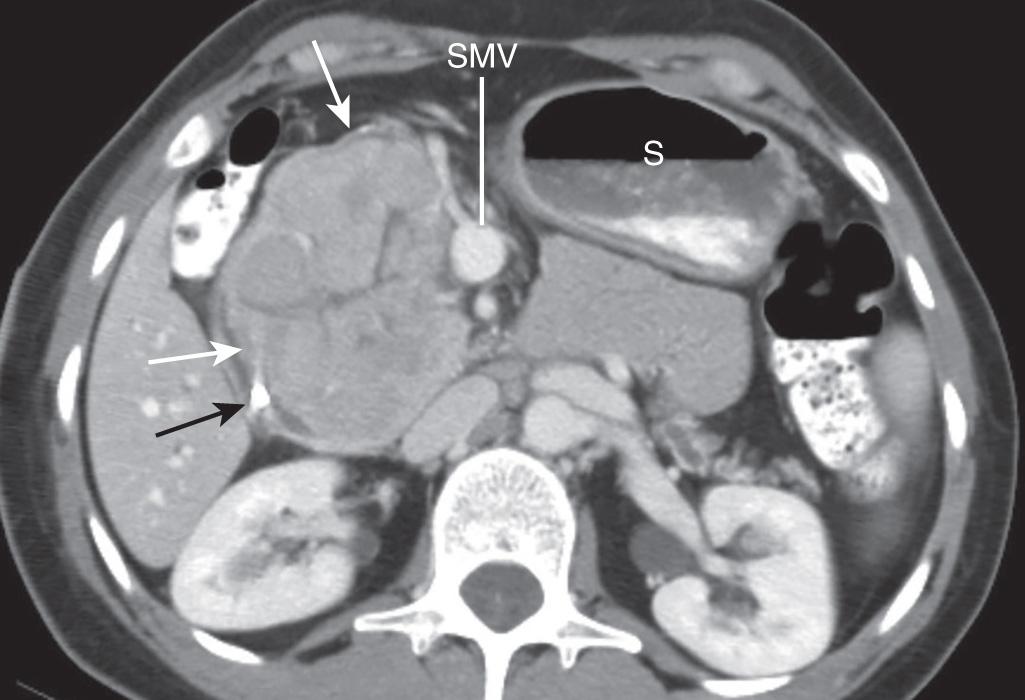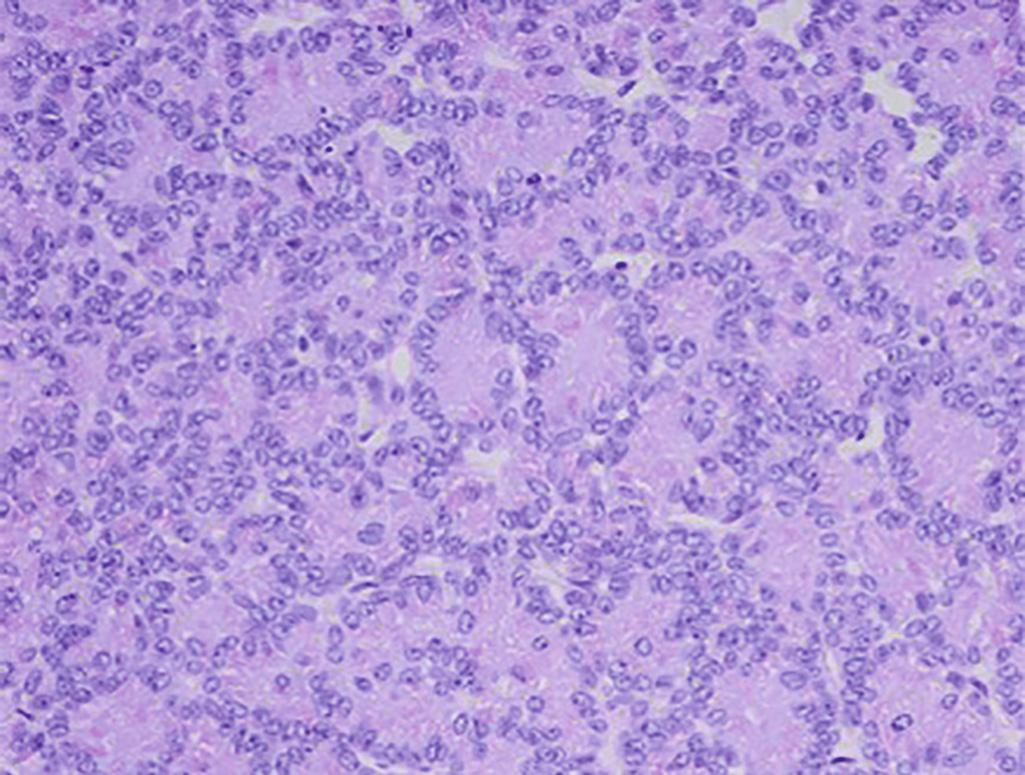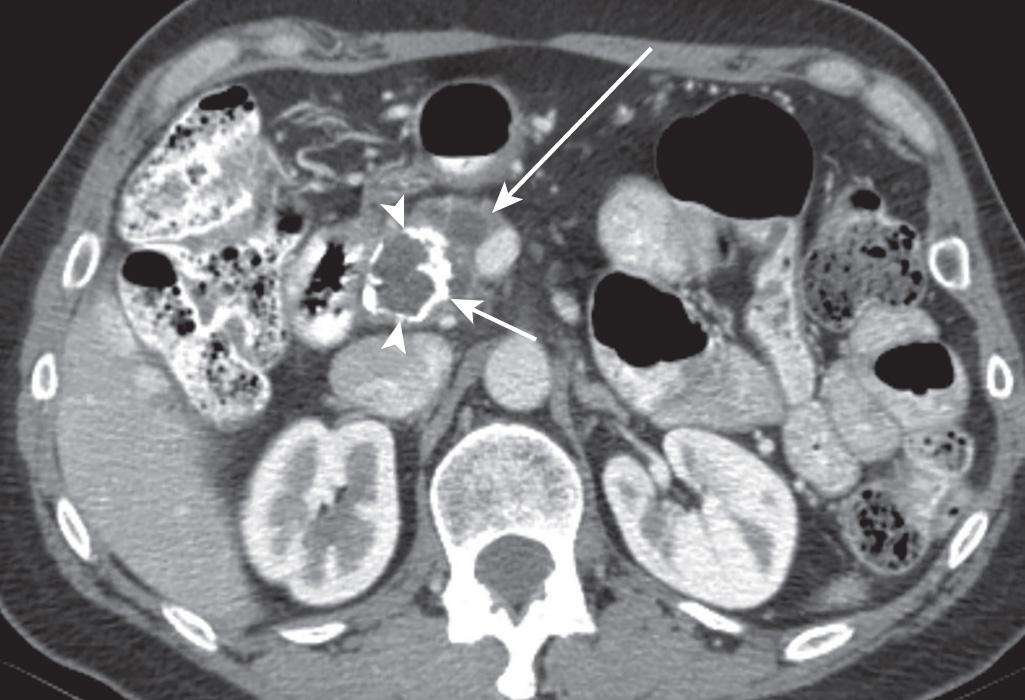Physical Address
304 North Cardinal St.
Dorchester Center, MA 02124
Although pancreatic ductal adenocarcinomas account for approximately 85% of all pancreatic tumors, epithelial tumors of the pancreas are increasingly being identified due to the frequent and improved quality of abdominal imaging modalities, such as computed tomography (CT). Solid pancreatic masses with atypical clinical presentations or unusual imaging characteristics may be diagnostically challenging, and familiarity with less common pancreatic conditions is necessary to develop a comprehensive differential diagnosis and help to avoid a delay in diagnosis. This chapter will focus on unusual solid tumors of the pancreas and discuss optimal diagnostic and therapeutic approaches for management.
Acinar cell carcinomas (ACCs) account for less than 1% of pancreatic cancers. In contrast to pancreatic ductal adenocarcinoma, ACCs arise from the acinar elements of the exocrine pancreas, not ductal epithelium. As a result, ACCs often retain the exocrine characteristics of normal pancreatic acini and can produce digestive enzymes such as trypsin, chymotrypsin, and lipase. These tumors are more common among men (male to female ratio of 2 : 1) and usually occur in the sixth and seventh decades of life. Approximately 50% of patients are asymptomatic at initial presentation; however, some patients may present with abdominal pain (45%) or weight loss (35%). Approximately 10% of patients with ACC may present with a paraneoplastic syndrome caused by excessive pancreatic enzyme production, which is characterized by the presence of subcutaneous fat necrosis, bony infarcts, arthritis, and eosinophilia. Although no specific serum or plasma tests exist that are diagnostic for ACC, serum lipase levels may be elevated in up to 25% of patients. Serum tumor markers such as carbohydrate antigen 19-9 (CA 19-9), α-fetoprotein (AFP), and carcinoembryonic antigen (CEA) are variably expressed. In some patients, the combination of serum lipase and AFP can be quite helpful in assessing tumor burden in response to therapy.
ACCs tend to be large (7 to 10 cm) solitary tumors at presentation. The lesions can be entirely solid when small, but larger tumors often outgrow their blood supply and develop central areas of necrosis. The location of ACC within the pancreas has been reported as head (47%), tail (47%), neck (3%), and uncinate process (3%). Characteristic cross-sectional imaging findings include the presence of a large, exophytic, well-circumscribed mass with capsular enhancement but central hypodensity ( Fig. 99.1 ). There may also be internal foci of calcifications, although calcifications are not a distinguishing feature. Similar to pancreatic adenocarcinoma, ACCs are often metastatic at presentation, with the liver being the most common site of metastasis. Unlike pancreatic ductal adenocarcinomas, ACCs are less likely to cause biliopancreatic ductal dilatation because they originate from the acinus. The radiographic differential diagnosis of ACCs includes pancreatic ductal adenocarcinoma, pancreatic neuroendocrine tumor, solid pseudopapillary tumors (SPTs), pancreatoblastoma, and mucinous cystic neoplasms.

On histopathologic examination, pure ACCs have two predominant cellular patterns of growth: an acinar pattern consisting of cells growing in well-formed acini and a solid pattern characterized by sheets of cells that lack the prominent stromal component seen in pancreatic ductal adenocarcinoma. The tumor cells have a uniform appearance with large, centrally located nucleoli with cytoplasm that is typically eosinophilic ( Fig. 99.2 ). Classically, the majority of ACCs will have coarse granular apical cytoplasmic staining for trypsin or chymotrypsin. In contrast to the staining pattern of pancreatic ductal adenocarcinoma, ACCs generally stain negative for CEA and mucicarmine. Although fine-needle aspiration (FNA) biopsy can usually differentiate a pancreatic ductal adenocarcinoma from an ACC, the greater diagnostic dilemma is distinguishing between ACC and a well-differentiated pancreatic neuroendocrine neoplasm and pancreatoblastoma. The diagnosis of ACC can be challenging, owing to the morphologic and immunophenotypical overlap that ACCs have with pancreatic neuroendocrine tumors. ACCs can have scattered neuroendocrine cells present in up to 40% of cells. To distinguish the neuroendocrine cells, additional immunohistochemistry for synaptophysin and chromogranin A may be informative. When neuroendocrine cells comprise greater than 35% of the tumor, it qualifies as a mixed acinar-neuroendocrine carcinoma.

Recently, 21 ACCs were characterized by whole-exome sequencing. On average the tumors had 64 somatic mutations, and no common gene was mutated in more than 30% of cancers. The number of nonsynonymous mutations found in ACC is greater than that observed in such tumors as pancreatic ductal adenocarcinoma or prostate and hepatocellular carcinoma but less than that noted in melanoma and lung cancer. Several genes, including ATM , BRCA2 , and PALB2 , which have been associated with pancreatic ductal adenocarcinoma, were also identified as mutated in ACCs. However, key driver mutations present in pancreatic adenocarcinoma, including KRAS , TP53 , CDKN2A , and SMAD4, were found to be infrequently mutated in ACCs. Interestingly, the genetic mutations associated with the major types of pancreatic cancer are now known to be relatively distinct: pancreatic ductal adenocarcinomas are characterized by mutations in SMAD4 , TP53 , KRAS , and CDKN2A ; neuroendocrine tumors by mutations in MEN1 , DAXX , ATRX , and the mTOR pathway; mucinous cystic neoplasms by mutations in RNF43 ; and intraductal papillary mucinous neoplasms by mutations in GNAS and RNF43 . ACCs have been found to express BCL10, which is absent in pancreatic ductal adenocarcinomas and neuroendocrine tumors. Although ACCs are microsatellite stable, they exhibit a high degree of chromosomal imbalances, which may help to distinguish them from pancreatic ductal adenocarcinoma and neuroendocrine tumors. In a murine model of cells that express neurogenin-3 , deletion of the Tsc1 gene leads to activation of mTOR signaling, resulting in the development of ACC. The different molecular alterations found in pancreatic tumors make it possible to use DNA sequencing in those rare situations where the primary tumor or a metastatic biopsy is difficult to classify solely by histopathologic criteria.
Patients who have localized disease should undergo surgical resection. Although ACCs are generally large, they tend to be well circumscribed and are often amenable to complete surgical resection. In a review of the National Cancer Database, the 5-year survival rate of 865 patients who underwent surgical resection for ACC was 36.2%. Survival durations from single-institution series are even more favorable, with median survivals reported as high as 57 months for patients with localized disease who underwent complete surgical resection. ACCs have a high rate of recurrence, with 57% of recurrences occurring at a median follow-up of 15 months and 100% of recurrences occurring at a median of 31.4 months. Distant recurrence is most common, and, similar to pancreatic adenocarcinoma, liver and lung predominate. Adjuvant gemcitabine is often administered after complete resection, but ACCs have been reported to be less responsive to systemic chemotherapies as compared with pancreatic ductal adenocarcinoma. However, with the adoption of combination chemotherapy regimens, including chemotherapeutic regimens that use oxaliplatin and irinotecan, partial response rates in patients with metastatic disease have been reported in up to 30% of patients. Anecdotally, we have seen liver and lung recurrence after a long disease-free interval (greater than 4 years) in rare patients with ACC. In such situations, resection of a unifocal metastasis may be considered in an otherwise healthy patient. This also allows for histologic confirmation of the diagnosis and molecular profiling as a guide to further systemic therapy.
Solid pseudopapillary tumors (SPTs) of the pancreas are rare neoplasms with low malignant potential. SPTs have been associated with several other names, including Frantz tumors, Hamoudi tumors, and papillary cystic neoplasm. It is estimated that SPTs represent up to 3% of all pancreatic tumors and 6% to 12% of pancreatic cystic neoplasms. SPTs are notable for their high prevalence among women, most commonly occurring in the third decade of life and earlier (mean age, 22 years; range, 2 to 85 years). The most common presenting symptoms are abdominal pain (45%) and/or an abdominal mass (34%). In the asymptomatic patient, tumors may be discovered as a palpable mass on routine physical examination, as a mass seen on casual view of the abdomen, or as an incidental finding on imaging for an unrelated complaint. Serologic tests are often of little value with CA 19-9 elevated in 4.3%, amylase in 22.6%, and lipase in 29.3%.
On CT imaging, SPTs are characteristically large, heterogeneously enhancing lesions with solid and cystic components, and they frequently demonstrate peripheral enhancement and central calcification ( Fig. 99.3 ). On magnetic resonance imaging (MRI), SPTs have a low signal intensity on T1-weighted images and a high signal intensity on T2-weighted images. Ultrasound shows a hypoechoic or isoechoic lesion. These lesions can range from being completely cystic to completely solid. The cystic portion of SPTs is not a true cyst, but rather has a cystic appearance that is secondary to necrotic degeneration of the primary tumor. As the solid papillary vascular stalks within the tumor slough and hemorrhage, central necrosis can occur, resulting in cystic degeneration. Although SPTs can occur throughout the pancreas, they are perhaps slightly more common in the pancreatic tail and, when discovered, are generally large in size (mean diameter, 5.4 cm). The radiographic differential diagnosis of an SPT should include other cystic neoplasms, including mucinous neoplasms or serous cystadenomas, and intraductal papillary mucinous neoplasms, as well as cystic degeneration of a typically solid neoplasm, such as a pancreatic neuroendocrine tumor or ACC. However, age is important; in a young woman under the age of 30, SPT and pancreatic neuroendocrine tumor would be most likely. In a young woman under the age of 20, SPT would clearly be the most likely diagnosis (even an affected member of a family with multiple endocrine neoplasia type 1 (MEN1) is unlikely to have a large pancreatic neuroendocrine tumor if under the age of 20). FNA biopsy may be useful when routine imaging is inconclusive and diagnostic uncertainty exists. However, because of the tumor's largely necrotic composition, FNA biopsy can frequently be nondiagnostic.

Some defining histologic features of SPTs include the presence of solid cellular hypervascular regions without gland formation, and the presence of branching papillary fronds with sheets and degenerative pseudopapillae. Cells have eosinophilic granules within the nuclei, which are typically grooved. The immunophenotype stains positively for neuron-specific enolase, CD10, and has atypical nuclear staining for β-catenin, which is generally a cytoplasmic protein. Keratins, chromogranin, synaptophysin, and endocrine pancreatic enzymes are generally not expressed. SPTs often stain positive for progesterone receptors, whereas estrogen receptor positivity is more variable. SPTs have also been reported to positively stain for α-methylacyl coenzyme A racemase (AMACR) in contrast to ACC and neuroendocrine tumors of the pancreas, which do not. Aggressive histologic features, such as angioinvasion, perineural invasion, or extension into the surrounding pancreatic parenchyma, that were previously thought to portend worse clinical behavior have not been found to be associated with recurrence or disease-specific survival. Therefore there is no consensus on factors that are prognostic for patients with SPTs.
The genetic profile associated with SPT is different from adenocarcinoma, most notably for an absence of KRAS, GNAS, and SMAD4 mutations. Almost all SPTs harbor alterations in the APC/β-catenin pathway due to a mutation involving CTNNB1 (exon 3). Nuclear accumulation of β-catenin has been described in 95% of SPTs, and 74% of tumors overexpress cyclin D1, a downstream effector of β-catenin. Interestingly, BCL9L, a β-catenin stabilizing gene, is significantly decreased in SPTs, which may help to attenuate the protumorigenic effects of overactivation of the Wnt/β-catenin pathway. In addition, downregulation of miR-194 and SOX 9 (compared with pancreatic ductal adenocarcinomas and nonneoplastic pancreatic tissue) has been reported in SPTs. In addition, genes involved in the hedgehog and androgen receptor signaling pathways, as well as genes involved in epithelial mesenchymal transition, have been shown to be activated in SPTs.
Become a Clinical Tree membership for Full access and enjoy Unlimited articles
If you are a member. Log in here